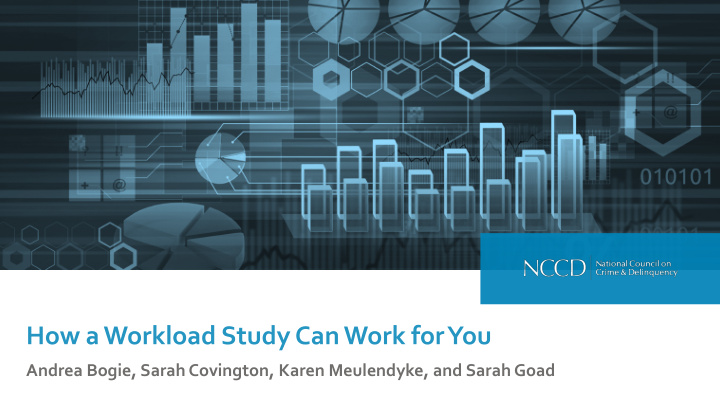



Andrea Bogie, Sarah Covington, Karen Meulendyke, and Sarah Goad
Agenda Objectives Workload Study Overview and Methodology Michigan 2015 Foster Care Workload Study Questions
Objectives • Workload study purpose, methodology • Requirements • Impact on juvenile justice and child welfare agencies
Workload Overview
What is workload? • The amount of work required to successfully manage and resolve assigned cases. • Reflects the average time it takes a worker to: » Do the work required for assigned cases; and » Complete non-casework responsibilities.
What is workload? Demand Supply Worker Worker hours hours needed available
Workload Versus Caseload Caseload : Number of cases assigned to a worker at a given time. Workload : Time it takes a worker to do what is required.
Consequences of High Workload • Preventable turnover • Turnover affects: » Case outcomes; » Cost; and » Workload of remaining staff.
Benefits of Manageable Workload • Manage organizational commitment and worker retention • Support worker attitudes and well-being • Achieve positive outcomes • Improve family engagement and delivery of quality services
Practical Purposes of a Workload Study
The Workload Study Question How many workers are needed in an agency to serve children and families in a way that meets agency standards?
Methodology
Example: Staff Hours Required to Meet Standards* Contact Standards by Case Type Average Hours per Month Intake 1.4 Investigation: Type 1 18.6 Investigation: Type 2 4.9 Ongoing Service Case: Intensive Risk 10.6 Ongoing Service Case: Low Risk 4.6 *Time estimates include ONLY the sampled cases that met agency standards.
Does meeting standards make a difference in workload? 7.0 3.6 2.4 2.2 2.0 1.5 Low Risk Moderate Risk High Risk Standards NOT Met Standards Met
Time Available Work Hours Per Month 173.3 Deduct 9.2 Vacation 4.0 Sick Leave 173.3 – 31.2 – 21.5 = + 18.0 Holidays/Break Time, etc. 120.6 hours 31.2 available per month Deduct 5.5 Case Support Time + 16.0 Administrative/Training Time 21.5
Workload Demand: Hours Required to Meet Standards # of Study Total Class/Type Calculation Cases Estimate Hours 600 Intake 1.4 hours 600 x 1.4 = 840 300 Investigation: Type 1 18.6 hours 300 x 18.6 = 5,580 200 Investigation: Type 2 4.9 hours 200 x 4.9 = 980 Ongoing Service Case: 100 10.6 hours 100 x 10.6 = 1,060 Intensive Risk Ongoing Service Case: 300 4.6 hours 300 x 4.6 = 1,380 Low Risk Total Agency Workload Demand (Hours Per Month) 9,840
Example: Workers Necessary 9,840 hours demanded 120.6 hours available per worker 82 Workers Necessary In total, 82 full-time workers are required in order to meet agency standards.
Benefits of Prescriptive Case-Based Approach • Incorporates agency standards to determine staffing demand. • Accurately estimates the time required to meet expectations under actual field conditions. • Encourages positive case outcomes through realistic staffing estimates.
2015 Foster Care Workload Study
Lessons Learned • Leave more time for staff input • Engage private providers early on to ensure representation • Take time to plan
Michigan’s Next Steps • Reduce caseload • Worker relief • System enhancements • Policy changes • Recruitment and retention (secondary trauma)
What is needed for a workload study? • Case-level data • Human resources data: Leave time, mandatory training, etc. • Strong leadership support and communication • Worker support and investment • Sufficient time for planning and data collection
Thank you! Than Thank y you! ou! For more information, visit www.nccdglobal.org or call (800) 306-6223
Recommend
More recommend